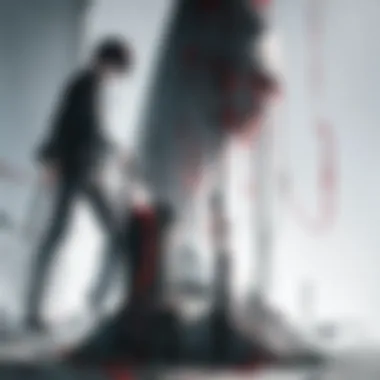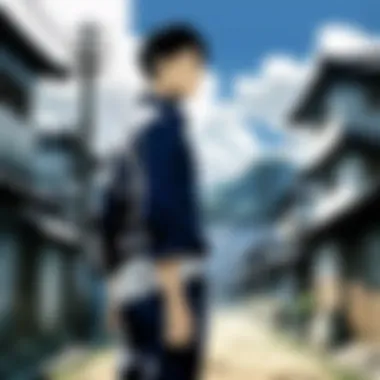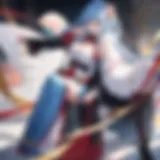Exploring Ajin: Themes, Impact, and Cultural Significance


Intro
To commend the manga series Ajin, one must first dive into the essence of its narrative. Published originally in 2012, the series introduced readers to a world intertwined with existentialist themes, questions of morality, and the concept of immortality through the presence of Ajin - beings who cannot die. The series captures the imaginations of audiences by presenting a unique take on what it means to be human and the implications that come with perpetual existence.
Set against a backdrop of societal upheaval, Ajin explores the boundaries of ethics, particularly through its characters, who grapple with their newfound immortality. This exploration leads to complex dialogues about the value of life and the morality of those who seek to exploit or harm others for their gain. As we embark on this journey of Ajin, we will break down its thematic significance, character arcs, and the cultural reflection it offers in today's context.
Intro to Ajin
Understanding Ajin is pivotal for anyone delving into the realms of modern manga and anime. This series doesn’t just serve as entertainment; it challenges perceptions about life, death, and the moral gray areas in between. With compelling themes packed into its narrative, Ajin stands out as a significant cultural artifact in today’s media landscape. The first step in this exploration involves dissecting its origins and basic premise—elements that lay the groundwork for its deeper themes and societal reflections.
Origin and Publication
Ajin, written and illustrated by Gamon Sakurai, first graced the pages of Good! Afternoon magazine in 2012. It quickly captured the attention of readers with its gritty storytelling and unique premise. The manga's evolution is noteworthy; starting from a mere serialized format, it expanded into several volumes, culminating in its collection of over 11 tankobon volumes by 2016.
This rapid growth in popularity paved the way for its adaptation into an anime series in 2016, further cementing its place in cultural discussions. The choice of publisher and the platform played a crucial role in its accessibility and reach, ensuring that Ajin reached a global audience. From its inception, it was clear that the series wasn't just another manga. It sparked conversations about the societal implications of immortality and different ethical dilemmas attached to it.
Basic Premise
At its core, Ajin revolves around Kei Nagai, a teenager who discovers he is one of the rare beings known as "Ajin"—essentially immortal creatures that can resurrect after death. This premise ignites a plethora of questions about identity and humanity when he finds himself hunted not just for his newfound abilities but also for what they represent within a world fraught with paranoia and suspicion. In a society that views Ajin as threats, the struggle between survival and the pursuit of one’s humanity becomes central.
The theme of isolation is particularly striking here. While Kei and his fellow Ajin long for acceptance, they also face an existential dread that explores the paradox of being immortal within a society that vehemently rejects them. The narrative utilizes this unique premise to probe deeper into personal and societal issues, making it a rich subject for analysis.
"The story of Ajin is more than just about immortality; it questions the essence of living and dying in an unforgiving world."
By laying this foundational groundwork, the article sets the stage for a deeper examination of the themes and cultural impact of Ajin, making it imperative for readers to grasp its beginnings.
Core Themes
In the landscape of manga and anime, themes often serve as the backbone of storytelling. They guide the audience through the experiences of characters while intertwining complex societal reflections. In Ajin, the core themes offer a rich tapestry of philosophical dialogues and ethical dilemmas, making the series stand out. These themes engage not just the characters within the narrative, but also resonate deeply with the audience, pushing them to ponder essential questions about life and existence.
Immortality and Its Consequences
The central idea of immortality in Ajin isn't celebrated as a boon but rather dissected as a double-edged sword. The story introduces Ajins, human beings who cannot die. On the surface, one might think that living forever could be a dream come true; however, the series swiftly illustrates the grim realities that accompany such a fate. Unrestrained by the fear of death, Ajins are subjected to societal outrage, systematic exclusion, and brutal experimentation by the state. This predicament shows that immortality isn't merely a state of being endless; it often leads to a loss of control over one's life, drawing a stark parallel to the human experience of being trapped by expectations and societal norms.
"In Ajin, the curse of immortality reveals that living forever might not equate to truly living. The effects of being both hunted and feared create dichotomies that challenge our typical perceptions of life and death."
Through the lens of immortality, the narrative invites readers to explore their beliefs about life, encouraging them to reflect on what it genuinely means to live a fulfilling life.
Identity and Humanity
The exploration of identity is another compelling theme in Ajin. As Ajins grapple with their unique conditions, they begin to question their humanity. Their existence challenges normative definitions of what it means to be human, blurring the lines between human rights and biological anomaly. The protagonist, Kei Nagai, embodies this internal struggle as he navigates the complexities of accepting who he truly is while battling societal prejudices. This theme underscores a crucial point: identity can often feel fragmented when forced into a box defined by others.
Readers are prompted to consider how societal labels shape personal identity. Are we defined more by the labels we carry or by our intrinsic qualities? The questions posed through Kei's journey ultimately urge the audience to engage in a critical self-reflection on their own identities in a world filled with biases and classifications.
Societal Isolation and Alienation
The sense of isolation permeates Ajin, presenting a reality that many can relate to, regardless of the circumstances. As society ostracizes Ajins, the series highlights the deep psychological scars that isolation inflicts. From the perspective of the Ajins like Kei, their struggles amplify feelings of loneliness and alienation, mirroring real-world experiences of those who are marginalized.
This theme serves as a reminder that the desire for acceptance often clashes with societal standards. Readers might find themselves reflecting on their own experiences of feeling like an outsider, whether due to adult pressures, cultural differences, or personal choices. Ajin taps into those feelings, extending a bridge between character experiences and audience empathy.


Character Development
Understanding character development in Ajin is vital, as it significantly influences the narrative and the themes explored within the series. The evolution of characters not only drives the plot forward but also serves as a lens through which various ethical, social, and existential dilemmas are examined. The way characters react to their circumstances—particularly in the context of immortality—provides profound insights into human nature and societal behavior. This section dissects the main protagonist, Kei Nagai, as well as the supporting characters and antagonists, painting a comprehensive picture of the character dynamics that enrich the story.
Main Protagonist: Kei Nagai
Kei Nagai serves as the heart of Ajin, representing a complex blend of vulnerability and resilience. At first glance, he is an ordinary high school student, but upon discovering he is an Ajin, his life takes a drastic turn. The reality of being immortal forces Kei to confront his own identity and morality. Throughout the series, he transitions from a self-absorbed individual into a more nuanced character grappling with profound existential questions.
The psychological layers of Kei's character are particularly noteworthy. He embodies the struggle between self-preservation and the ethical implications of his immortality. For instance, during intense confrontations with both humans and fellow Ajin, Kei's choices often reflect deep-seated fears and aspirations, highlighting the toll of his condition. His emotional development not only resonates with readers but also opens up discussions about the implications of eternal life:
"Being immortal isn't just a gift; it comes with immense burdens."
This internal conflict makes him relatable, urging audiences to ponder what it truly means to live a meaningful life.
Supporting Characters and Their Roles
The supporting cast in Ajin plays a significant role in framing the narrative around Kei's journey. Each character brings a unique perspective, often reflecting different facets of society's response to the existence of Ajin. Take, for instance, Kaito, who serves as both a friend and ally to Kei. Kaito’s steadfastness and loyalty contrast sharply with the volatility of many other characters, showcasing the essence of human connection amid chaos.
Additionally, characters like Eriko Nagai, Kei's mother, illuminate personal stakes in the story. Her unconditional love and subsequent torment introduce familial themes, complicating Kei's predicament. Each supporting character is crafted with distinct motives, strengths, and vulnerabilities, enriching the narrative fabric.
Their interactions with Kei not only enhance the plot but also emphasize the overarching themes of alienation and identity. Moreover, seeing how various characters react to the concept of Ajin—some embracing and others rejecting—illustrates the spectrum of human emotion and ethics, grounding the more fantastical elements of the story in real-world implications.
Antagonists: A Deeper Look
Antagonists in Ajin are not merely obstacles for Kei; they represent a broader commentary on society's darker facets. Characters like Sato, a rogue Ajin, challenge the moral compass of every character he encounters. His unbending belief in the superiority of Ajin serves as a catalyst for conflict, raising essential questions about power and its abuses.
Sato’s character transcends the typical villain archetype, showcasing a fascinating duality; he is both fearsome and deeply flawed. His actions spark debates about the ethics of immortality and the lengths one might go to achieve freedom.
Moreover, government agents pursuing Ajin embody institutional powers, illustrating how society at large often views the unknown with suspicion and hostility. Characters like these prompt audiences to reflect on social justice issues, drawing parallels between fiction and the struggles faced in real life.
In summary, character development in Ajin is not a mere accessory to the plot; it is the driving force that navigates through its themes of identity, morality, and societal perception of the other. The profound evolution of Kei, the depth of supporting roles, and the complexity of antagonists invite readers to engage with the narrative on multiple levels, soaring beyond mere entertainment into a rich tapestry of philosophical inquiry.
Visual and Stylistic Elements
When considering the world of anime and manga, visual and stylistic choices often hold as much weight as the narrative itself. In the case of Ajin, these elements play a pivotal role not only in how the story is perceived but also in how it resonates with audiences. Through careful artistry, Ajin distills essential themes into visual language, creating a unique experience that invites viewers deeper into its philosophical explorations.
Art Style and Its Impact
Ajin employs a distinctive art style that reflects the series' darker themes and complex storylines. The character designs are minimalistic, yet striking. Characters often carry an aura of unease and detachment, underscoring their struggles with identity and humanity. For instance, the sharp features and subdued color palettes effectively convey a sense of alienation, mirroring the characters’ own experiences within society. This choice in design signifies more than just aesthetics; it enforces the idea of social isolation that runs rampant throughout the series.
Additionally, the depiction of Ajin themselves—those immortal beings who exist outside the norms of humanity—brings a level of discomfort. Their somewhat ghostly appearance serves to underline the grotesque nature of their existence. When one observes how the Ajin can regenerate from fatal injuries, it’s not just a demonstration of immortality; it’s a visual commentary on the uncanny nature of those who exist outside the bounds of life and death.
Use of Color and Shadow
Color and shadow in Ajin act as silent narrators, adding layers to the storytelling that words alone may not convey. The series typically employs a muted color palette, shifting away from vibrant, cheerful tones. This choice enhances the foreboding atmosphere, often associating specific colors with certain emotions or themes. For example, darker shades of blue and gray often accompany scenes of introspection or violence, creating an underlying tension that remains palpable throughout the viewing experience.
Moreover, the use of shadow plays a critical role in dramatizing key moments. Shadows are not merely background details; they often frame characters in ways that reflect their emotional states. A character engulfed in shadows may embody despair or conflict, while a brighter backdrop can symbolize moments of clarity or vulnerability. This dynamic use of light and dark also represents the duality of human nature—the push and pull between the light of humanity and the dark truths that lie beneath.
"In Ajin, visuals are not just illustrations; they are integral components of the storytelling fabric, merging with plot and character development to provide depth and meaning."


By harnessing visual elements effectively, Ajin enriches its narrative complexity. The careful consideration of art style, combined with the strategic use of color and shadow, cultivates an atmosphere that invites viewers to reflect on the deeper implications of the story. In doing so, the creators of Ajin ensure that their work is not merely a vessel for action and plot twists but a profound exploration of existential themes that resonates with audiences on multiple levels.
Narrative Structure
In the examination of 'Ajin,' the narrative structure functions as the backbone of its storytelling. This structuring of the plot is critical as it shapes the audience’s experience, controls the flow of information, and drives the emotional engagement throughout the series. A well-executed narrative structure keeps readers on the edge of their seats, compelling them to turn the page or stream the next episode, ensuring they remain engrossed in the unfolding drama of characters grappling with their existential dilemmas.
Pacing and Tension
The pacing of 'Ajin' is deftly balanced. From the opening scenes, the series grabs the viewer’s attention with swift revelations about the world of Ajin—immortal beings hunted due to their nature. This rapid pacing is particularly evident in the initial chapters when the protagonist, Kei Nagai, comes to terms with his new reality. Such quick developments serve to establish urgency and provide a sense of looming danger. The series oscillates between fast-paced action sequences and moments of introspection, allowing for dramatic tension that keeps watchers captivated.
- Fast-paced moments often showcase intense battles, leading to cliffhangers that heighten suspense.
- Slower sequences, on the other hand, delve into the philosophical implications of immortality and what it means to be human, asking viewers to reflect on these complex themes.
Ultimately, this deliberate rhythm plays a pivotal role in maintaining interest while also creating a layered narrative that resonates deeply with the audience’s psyche. By mixing moments of thrill and contemplation, the pacing enhances the overall impact of the story.
Flashbacks and Their Significance
Flashbacks in 'Ajin' serve more than just a storytelling function; they provide critical insight into the characters' motivations and past experiences. Such narrative devices not only enhance character depth but also weave a richer tapestry of interrelated events that inform the present narrative. Flashbacks often reveal how past trauma influences decisions made in the current timeline, adding emotional weight to the storyline.
For instance, sequences that explore Kei's prior life before becoming an Ajin allow the audience to connect with him on a personal level, understanding his fears and the stakes involved.
"These brief returns to the past often amplify the audience’s empathy towards characters, showcasing their struggles and the shifting nature of their identities."
Through these glimpses into former lives, creators of 'Ajin' successfully foster a narrative that transcends simple action, inviting viewers to explore deeper existential themes while enhancing overall narrative cohesion.
In summary, the narrative structure of 'Ajin' is instrumental in how the story is conveyed, offering a dynamic interplay of pacing and the intricate use of flashbacks that ultimately shape a compelling experience for both anime and manga enthusiasts.
Ajin in Pop Culture
The impact of Ajin in popular culture is pretty significant, marking a unique transition in how manga and anime can influence broader media. Its exploration of themes such as immortality, identity, and societal alienation resonates deeply with contemporary society, challenging both creators and audiences to think critically about the subjects at hand. This engagement goes beyond mere entertainment, prompting meaningful discussions and reflections.
Influence on Other Works
Ajin has established itself as a trailblazer within the anime and manga industries, inspiring a range of stories across various media. For instance, many creators have begun to incorporate darker themes related to immortality and the moral dilemmas attached to it, often echoing the Ajin narrative. A prime example can be seen in Tokyo Ghoul, where the fear of the unknown and the burden of self-identity are prominent. Such influences not only suggest that Ajin has seeded ideas in others’ minds but also encapsulates a broader, cultural tide towards narratives that question the attributes of humanity.
Additionally, the stylistic elements of Ajin, particularly its unique depiction of "Ajins"—the immortal beings—have inspired visual storytelling in video games, such as Dark Souls. The spiritual and ethical conundrums presented in these games echo the complexities in Ajin, inviting players to navigate through their moral choices. This cross-pollination of themes illustrates the expansive reach of Ajin within pop culture, influencing myriad forms of artistic expression.
"Through its unique exploration of existential themes, Ajin opens a door to conversations that resonate far and wide in the realm of manga and anime."
Merchandising and Media Adaptations
The commercial success of Ajin can’t be overlooked; it has generated an impressive amount of merchandise and adaptations that have broadened its reach. Figurines depicting characters in their distinct styles have been highly sought after, allowing fans to own a piece of this captivating story. Moreover, the manga's success has led to animated adaptations, including both a television series and anime films, further amplifying its cultural footprint.
Along with traditional avenues like DVD releases and streaming on major platforms such as Crunchyroll, the story has also made its way into video games. These adaptations often enhance the viewing experience by allowing fans to immerse themselves in the Ajin universe. The synergy between the original manga and these adaptations strengthens its overall presence in the market.
Philosophical Implications
The exploration of Ajin brings various philosophical questions to the forefront, particularly concerning the ramifications of immortality and what it means to be truly human. The narrative challenges its audience to reflect on the ethical and existential dilemmas tied to the idea of living forever. As readers dive deeper into the story, they may find themselves engaged in a broader conversation about life, death, and the value of existence.
Ethics of Immortality


Immortality might sound like a gift, a blessing that everyone would yearn for, yet Ajin presents a significantly different perspective. The constant resurrection experienced by Ajin, or demi-humans, raises poignant ethical concerns. In a world where death is no longer an absolute end, how do values such as life, morality, and personal sacrifice evolve?
The series unearths the contrasting societal views on Ajin, often depicting them as mere guinea pigs for scientific experimentation. Here, we stumble into the crux of the ethical debate: do the ends justify the means? Although some might argue that advances in science are pivotal, at what cost are these advancements made? Ajin offers no clear answers but, instead, allows us to sit in the discomfort of these questions.
Beyond the individual level, this also invites contemplation on societal structures that often prioritize progress over morality. Utilitarian ethics come into play here; can the suffering of a few be justified by the supposed benefits to society? As we watch Kei Nagai and others navigate this reality, viewers are confronted with moral ambiguity that invites discussion and reflection.
"Immortality, while alluring, can turn companionship and hope into weapons of despair and loss."
Existential Questions Raised
Existentialism is a key thread in the fabric of Ajin. Characters are pushed to confront the significance of their existence in a world where they are often marginalized or feared. The narrative meticulously crafts scenarios that challenge the essence of humanity itself. If immortality strips away life’s meaning, does it gradually dilute the value of choices and experiences?
Essentially, Ajin poses fundamental questions:
- What does it mean to be human?
- Is suffering a necessary aspect of existence?
- How does perpetual life reshape desire and ambition?
These queries echo throughout the story, demonstrating that life’s fragility leads to its inherent beauty. For characters like Kei Nagai, moments of reflection become increasingly significant. They challenge themselves to find purpose amidst the chaos and uncertainty that immortality brings.
Through these philosophical implications, Ajin reveals a profound introspection regarding the human condition, shaking the foundation of what we understand about life and mortality.
In the grand tapestry of storytelling, these themes resonate, compelling readers to engage on a personal level, potentially reconsidering their own views on existence.
Reception and Critique
The reception and critique of Ajin play a pivotal role in understanding the broader impact of the series within the anime and manga landscape. This section underscores how introductory responses from both critics and fans shape the conversation around the story, offering insights into its thematic weight, as well as its influence on future works.
Critical Acclaim and Awards
Ajin has not just found its way into the hands of regular readers; critics have taken notice too. The series boasts impressive accolades, which is no small feat in the crowded realm of manga. For instance, it won the Best Graphic Novel award at the 2016 Eisner Awards, a recognition that speaks volumes about its narrative structure and artistic execution. Critics praise the intricate storytelling and moral inquiries it poses about immortality and identity.
Moreover, the animation adaptation was lauded for its effort to stay true to the source material while also introducing elements like CGI that caught the eye of a diverse audience. Such critical reception not only affirms the series' place in popular culture but also showcases its meticulous attention to detail. While some argue that its dark themes may not appeal to a mainstream audience, they also serve to elevate the dialogue surrounding the series and its relevance.
Fan Reactions and Analysis
Fan reactions constitute another significant facet in the evaluation of Ajin. The community often engages in lively discussions on forums like Reddit and Facebook, dissecting plot twists and theorizing about character motivations. Fans have coined hashtags that reflect their affinity for the series, with phrases like "#TeamNagai" popping up frequently among passionate discussions. This level of engagement reflects deeper connections formed between characters and viewers, indicating that the themes of isolation and the struggle for acceptance resonate on a personal level.
Furthermore, many fans have noted how the series reflects societal issues, such as discrimination and fear of the unknown. Readers frequently highlight how the story manages to encapsulate the essence of what it means to be different in a world that often shuns the unconventional. This shared understanding creates a strong community backbone where fans not only enjoy the content but also feel validated in their interpretations.
In closing, both the critical praise and the shared enthusiasm of the fanbase contribute to Ajin’s overall significance in the genre. Its ability to provoke deep discussions while also earning accolades establishes it as a multifaceted work that continues to resonate with audiences, thereby solidifying its legacy in the cultural consciousness.
Finale
The exploration of 'Ajin' culminates in a significant understanding of not just the narrative itself, but also the deeper implications it carries within the anime and manga landscape. This concluding section reflects on the overall importance of the work, particularly regarding the key themes of immortality, identity, and societal alienation.
Overall Significance in the Genre
At its core, 'Ajin' stands as a bulwark within the genre, challenging traditional narratives with its nuanced portrayal of the human experience when faced with the extraordinary. The concept of immortality isn't merely a fantastical extension; instead, it lays bare the vulnerabilities and ethical dilemmas that emerge when life becomes perpetual. Readers witness the struggles of Kei Nagai, who battles not just for survival, but also for the right to define his existence amidst society's fears and prejudices.
Additionally, 'Ajin' distinguishes itself through its unique art style and storytelling techniques. The way in which the narrative unfolds invites audiences to engage in profound philosophical questions, thereby elevating its status beyond mere entertainment. This pivoting depth and exploration of existential themes resonate strongly with contemporary issues, reflecting the anxieties felt in a world that is increasingly uncertain.
Future of Ajin and Its Legacy
Looking forward, the legacy of 'Ajin' appears bright, with its intricate themes set to inspire future works in the field of anime and manga. Its influence has already seeped into various media adaptations, including animations and live-action films, each contributing to the wider dialogue on the ethical implications of immortality. As audiences continue to crave content that challenges their perceptions, 'Ajin' serves as a template for creators seeking to delve into complex moral landscapes.
In a fast-evolving industry, it is clear that 'Ajin' will remain a reference point. The empowerment of characters like Kei Nagai exemplifies a shift towards making flawed, relatable protagonists who showcase resilience against societal norms. This trend could encourage more diverse narratives, enriching the genre.







